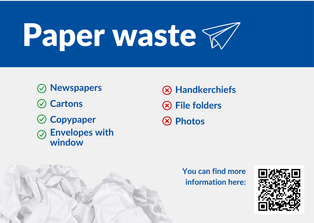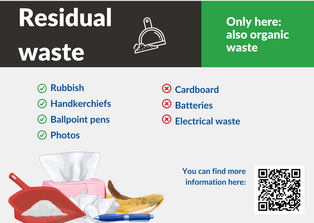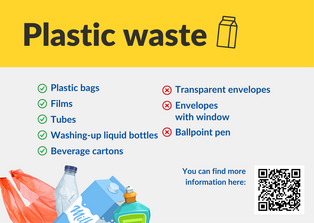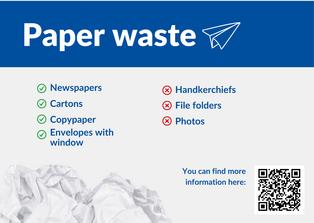Services for all
at UW/H
Services for all
at UW/H
You are here:
Waste separation

Competently separated: less waste, more recyclables!
UW/H produces more than 100 tons of waste per year; in 2022, for example, the figure was 118.56 tons. Only 20 tons of this is pure paper waste. This means that a lot of paper ends up in residual waste, even though it could still be reused. Every kilo of paper that is not disposed of correctly costs almost four times as much as proper disposal. This is not only expensive, but also ecologically unsound: paper that is thrown away separately and can thus be returned to the material cycle can be recycled 10 to 25 times.

Waste separation in the offices
There are waste paper bins in the offices which are emptied regularly. Please only dispose of paper in these bins. If contaminated with other waste, the paper cannot be recycled and valuable resources are lost.
For other waste - such as packaging, residual waste and organic waste - the insert on the wastepaper basket can be used for temporary storage. Simply remove it and dispose of it separately in one of the tea kitchens or one of the waste garbage cans in the corridors.
If we dispose of paper and cardboard separately, we can reduce wood consumption and thus contribute to fewer trees having to be felled with little effort.
Waste separation beyond the office
Waste separation system
In addition to the waste bins in the offices, there are waste bins for residual waste, plastic and sometimes paper in the kitchens, seminar rooms and public areas. Here you will find some information on correct separation:

You can dispose of your residual waste either in one of the tea kitchens or in one of the waste bins in the corridors.
Organic waste is also collected in the residual waste garbage can in the tea kitchens and seminar rooms.

You can dispose of your packaging waste either in one of the tea kitchens or in one of the waste bins in the corridors.

In addition to the paper bins in the offices, there are also paper bins in the corridors and public areas.
Cigarette butts at the UW/H
Cigarette butts are classified as hazardous waste due to the many toxic substances they contain. They are therefore collected at three locations at UW/H and then professionally recycled.
Cigarette butts cause a lot more work for our facility management. They also pose a considerable risk to plants and animals. The toxic substances in cigarette butts leach directly into the soil around the university and harm microorganisms. This is contrary to our goal of promoting a green campus with a high level of biodiversity.
We therefore ask everyone to use the collection stations to reduce the workload for Facility Management and to take joint responsibility for cleanliness and low pollution.
Tobacycle specializes in collecting and recycling cigarette butts in an environmentally friendly way in order to minimize the negative impact of smoking on people and the environment. The cigarette butts are collected dry in special collection containers, stored in separate garbage cans and collected by Tobacycle. Tobacycle recycles the cigarette butts professionally and produces new products from the residual materials.
Locations of the collection bins
- At the entrance to Cafe Larix (by the railings)
- At the red sofa outside
- At the back entrance of the main campus building
FAQ on waste separation at the UW/H
Hen or egg? Of course we can't expect the cleaners to rummage through our garbage. If the waste in the bins is not separated, unfortunately all the waste has to go in the residual waste.
It is important that we provide the cleaners with the best conditions so that they can do their job well. One thing is also clear: everyone has to participate. Because even waste that is only halfway separated cannot be emptied by type.
Especially in summer, it makes sense not to store the banana peel or empty yogurt pot next to the workstation for an unnecessarily long time. In many offices, the system of separating waste other than paper by the respective users has therefore proved successful. It also enables waste to be truly separated.
It is not ideal for organic waste to be disposed of with residual waste. However, the biggest problem at the moment is the large amount of paper in the waste and the lack of separation between the different types of waste. Once this problem has been solved, organic waste can also be introduced.
Waste separation at UW/H is a complicated matter that always raises questions. Many people are frustrated. We have therefore tried to clarify the most important questions here. If you have any further questions, please send an e-mail to: nachhaltigkeit@uni-wh.de